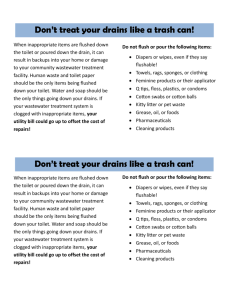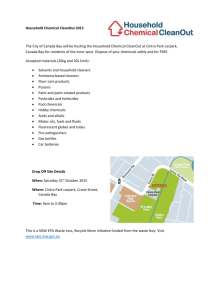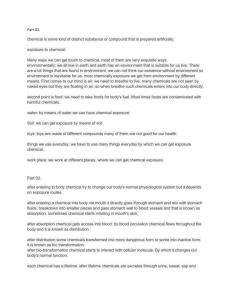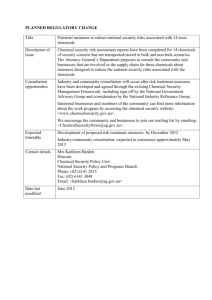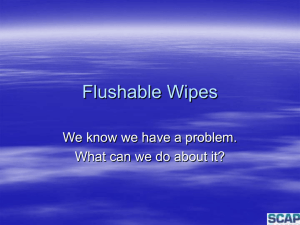File - Elisa Dawson
advertisement
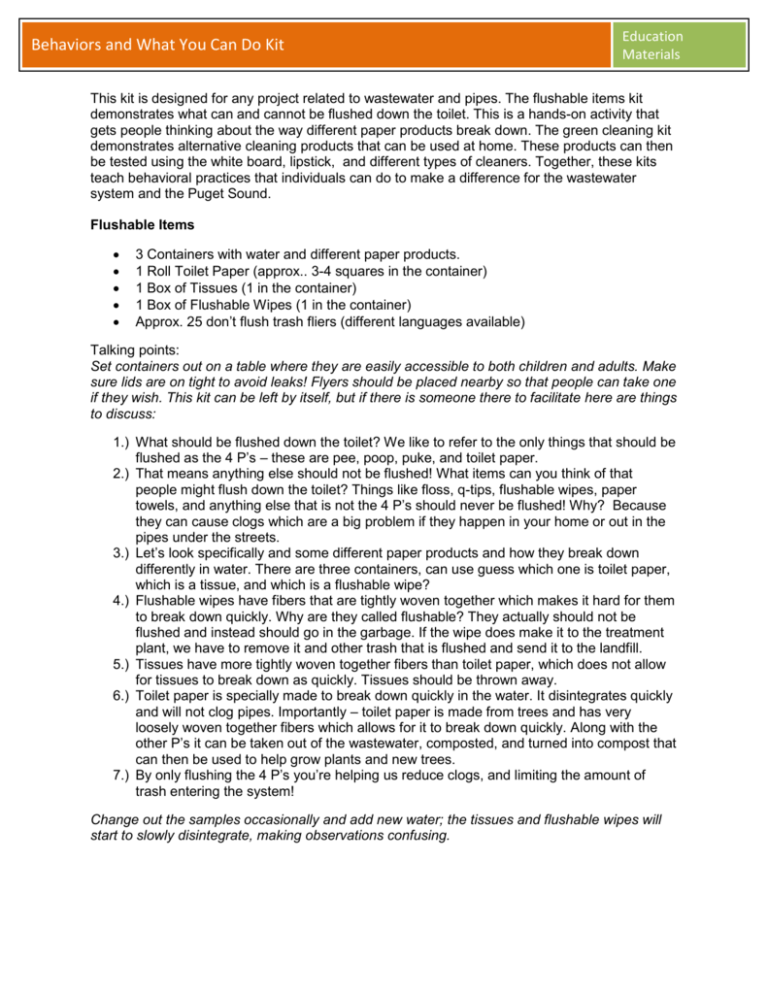
Behaviors and What You Can Do Kit Education Materials This kit is designed for any project related to wastewater and pipes. The flushable items kit demonstrates what can and cannot be flushed down the toilet. This is a hands-on activity that gets people thinking about the way different paper products break down. The green cleaning kit demonstrates alternative cleaning products that can be used at home. These products can then be tested using the white board, lipstick, and different types of cleaners. Together, these kits teach behavioral practices that individuals can do to make a difference for the wastewater system and the Puget Sound. Flushable Items 3 Containers with water and different paper products. 1 Roll Toilet Paper (approx.. 3-4 squares in the container) 1 Box of Tissues (1 in the container) 1 Box of Flushable Wipes (1 in the container) Approx. 25 don’t flush trash fliers (different languages available) Talking points: Set containers out on a table where they are easily accessible to both children and adults. Make sure lids are on tight to avoid leaks! Flyers should be placed nearby so that people can take one if they wish. This kit can be left by itself, but if there is someone there to facilitate here are things to discuss: 1.) What should be flushed down the toilet? We like to refer to the only things that should be flushed as the 4 P’s – these are pee, poop, puke, and toilet paper. 2.) That means anything else should not be flushed! What items can you think of that people might flush down the toilet? Things like floss, q-tips, flushable wipes, paper towels, and anything else that is not the 4 P’s should never be flushed! Why? Because they can cause clogs which are a big problem if they happen in your home or out in the pipes under the streets. 3.) Let’s look specifically and some different paper products and how they break down differently in water. There are three containers, can use guess which one is toilet paper, which is a tissue, and which is a flushable wipe? 4.) Flushable wipes have fibers that are tightly woven together which makes it hard for them to break down quickly. Why are they called flushable? They actually should not be flushed and instead should go in the garbage. If the wipe does make it to the treatment plant, we have to remove it and other trash that is flushed and send it to the landfill. 5.) Tissues have more tightly woven together fibers than toilet paper, which does not allow for tissues to break down as quickly. Tissues should be thrown away. 6.) Toilet paper is specially made to break down quickly in the water. It disintegrates quickly and will not clog pipes. Importantly – toilet paper is made from trees and has very loosely woven together fibers which allows for it to break down quickly. Along with the other P’s it can be taken out of the wastewater, composted, and turned into compost that can then be used to help grow plants and new trees. 7.) By only flushing the 4 P’s you’re helping us reduce clogs, and limiting the amount of trash entering the system! Change out the samples occasionally and add new water; the tissues and flushable wipes will start to slowly disintegrate, making observations confusing. Education Materials Behaviors and What You Can Do Kit Green Cleaning Bucket 1 Bottle of Olive Oil. 1 Bottle Castile Soap. 1 Bottle White Vinegar. 1 Box of Baking Soda 1 Container of Salt 1 Container of Hydrogen Peroxide. Corn Starch. Scouring Pads Green bucket Recipe handout Talking points: This kit can be set out for people to look at, and has an opportunity to test out different types of cleaners. Put the white board, lipstick, cleaners, and paper towels out so that people can test the different types of cleaners to see which one they think works best. If there is someone to facilitate a conversation, here are a few things to discuss: 1.) What sorts of things do we do in our house that makes water dirty? We use the toilet, wash our hands, do dishes, laundry, take showers and more. What do we add to the water that makes it dirty doing this? There’s organic waste (the 4 P’s: pee, poop, puke, and toilet paper), bacteria, trash, and chemicals. 2.) What kinds of chemicals do we use that make the water dirty? All sorts of cleaning products, soaps, and medicines. Each of these products contains lots of chemicals. 3.) The wastewater treatment plant can take out the trash, the 4 P’s, and can sanitize the water to kill off bacteria. The treatment plant uses biological processes, good bacteria, to break down the solids (poo, food, toilet paper) in the water and decompose it turning it into fertilizer and compost. These biological processes cannot equally break down all chemicals. 4.) There are thousands of different chemicals we interact with each day (count products and ingredients in your daily life). Chemicals are very small, they dissolve in water and there is no single treatment system that can make them all ‘go away’ 5.) When the water is done at the treatment plant, it is sent through a pipe to the Puget Sound where it is discharged. This means that chemicals not consumed/broken down by bacteria at the treatment plant, will also go to the Puget Sound. 6.) Chemicals vary in the amount of time they take to break down. Some can take tens to hundreds to thousands of years. 7.) Chemicals can have adverse effects on the aquatic plants and animals. Chemicals can have adverse effects on the aquatic plants and animals. They can bio-accumulate up the food chain – accumulating the mammals at the top in higher amounts; and contaminating the fish, shellfish along the way. They can also change the way that these species respond to predators or reproduce. Limiting the types of chemicals and quantities of chemicals entering the water system, limits the quantities of chemicals entering the Puget Sound. 8.) Green Cleaners are made using more natural ingredients. These ingredients break down faster than man-made chemicals. Green cleaners can be bought at the store, or even made at home using basic ingredients. 9.) By using green cleaners you can reduce the amount of chemicals entering into the Puget Sound. 10.) Test out the different types of cleaners and see which one you think works best. Make three smears of lipstick on the white board, and then try one of the three different cleaners on each smear with a paper towel. Which one worked best?
